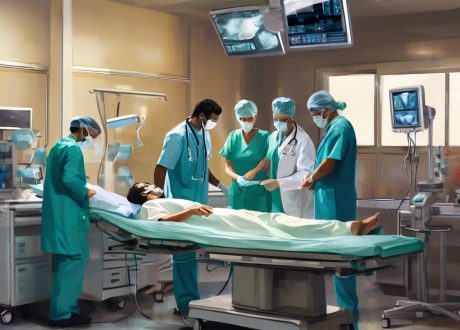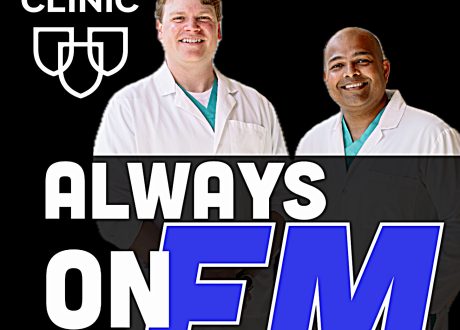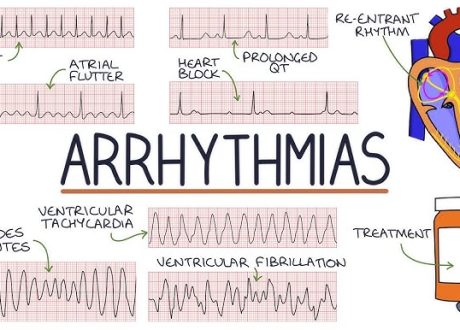Annals of Emergency Medicine, Copyright © 2021 American College of Emergency Physicians
SEE RELATED ARTICLE, P. XXX
Survival after an out-of-hospital cardiac arrest depends on each link in the “chain of survival,” from rapid activation of an emergency response and high-quality cardiopulmonary resuscitation (CPR) to early defibrillation, advanced resuscitation by emergency medical service (EMS) staff, and postresuscitation care. Time to the return of spontaneous circulation is an important surrogate for prognosis, and shorter durations of resuscitation are associated with more favorable outcomes. When to transport a patient to provide the best chance of the return of spontaneous circulation becomes an essential question. In this issue of Annals of Emergency Medicine , Park et al trained and internally validated models to predict the time to on-scene return of spontaneous circulation using time-to-event analyses and classification algorithms. Based on their work, we can take fundamental lessons about time-to-event analyses, algorithmic assistance in the out-of-hospital setting, and what artificial intelligence may mean for EMS.
To understand this study, we should first note the practice variation in EMS systems. According to the authors, EMS in South Korea uses a basic life support ambulance system managed by the National Fire Agency. EMS technicians can provide CPR on scene and during transport with the use of automated external defibrillators. Under direct medical control, EMS staff can also deliver intermediate-level services, including advanced airway management and intravenous fluids. What is crucial to recognize is that Korean EMS staff may not declare death on field. Per protocol, all patients with out-of-hospital cardiac arrest for whom EMS staff attempt resuscitation are transported to the nearest emergency department.
This perspective helps explain why a time-to-event analysis is such an important element conceptually and specifically in this work. The measurement of temporal association adds to its utility in the out-of-hospital setting, where time is of the essence: transport decisions have to be made, and there may be a greater likelihood of successful return of spontaneous circulation at the scene than during transport. The authors developed and validated prediction models for on-scene return of spontaneous circulation using time-to-event analysis algorithms, Cox proportional hazard regression (Cox), and additional machine learning models. As the authors noted, because they did not use any high-dimensional data in their modeling (such as CPR metrics, end-tidal carbon dioxide monitoring, or ECG findings), they were able to use standardized, available data to make predictions.
There are several strengths inherent in this relatively simple approach that incorporated a time-to-event analysis. First, it is well known that time to the return of spontaneous circulation is strongly associated with patient outcomes, and therefore, it is important to achieve early return of spontaneous circulation to enhance the likelihood of favorable outcomes. , An artificial intelligence algorithm that reliably provides the probability of achieving return of spontaneous circulation helps determine whether resuscitation continues on scene, continues during transport to a higher level of care, or is terminated. However, there is paucity of prediction models focusing on time to out-of-hospital return of spontaneous circulation for patients with out-of-hospital cardiac arrest, and previous data have shown large practice variation in intra-arrest transport across EMS agencies—some agencies transported nearly all patients, regardless of the return of spontaneous circulation, whereas others rarely transported patients without return of spontaneous circulation. The work by Park et al is conceptually innovative, in that they developed and internally validated novel prediction models for time to the return of spontaneous circulation using time-to-event analyses and, therefore, took initial steps to fill this gap. Second, the use of a national out-of-hospital cardiac arrest registry in Korea gave the authors a large sample size and high generalizability of results. Finally, the consistent performance across multiple prediction models suggests robustness of the results.
Critiques of the study are also easy to develop; however, rather than demonstrating the weakness of the algorithmic approach, they should be taken as an indication of how challenging it may be to translate results or, more germane to the current work, algorithms from one EMS system and apply them elsewhere. For example, it appears that epinephrine was not administered in the out-of-hospital settings in this study; the authors did not mention vasopressor administration, and it did not appear to be included in algorithm development. The lack of out-of-hospital epinephrine administration might, therefore, have affected the results of this current study. Epinephrine has been widely used for patients with out-of-hospital cardiac arrest by EMS staff in Europe and North America. A recent clinical trial in the United Kingdom reported that epinephrine administration in adult patients with out-of-hospital cardiac arrest resulted in a higher rate of achieving return of spontaneous circulation and survival compared with a placebo.
Additionally, Park et al showed a lower rate of the return of spontaneous circulation than previous reports. This study showed that the on-scene return of spontaneous circulation rate was 6.1% between 2013 and 2017 and 9.0% in 2018. A study using a regional out-of-hospital cardiac arrest registry in the Netherlands reported that 46% of patients with EMS-treated out-of-hospital cardiac arrest achieved return of spontaneous circulation on the scene, and another study from an out-of-hospital cardiac arrest dataset in North America showed that 42% of patients with EMS-treated out-of-hospital cardiac arrest had return of spontaneous circulation before the initiation of transport from the scene. , The on-scene return of spontaneous circulation rate in the current study, so distinct from that in prior studies, implies differences in patient populations and out-of-hospital practices. For example, this current study showed that among those with on-scene return of spontaneous circulation, the median interval (interquantile range) between EMS arrival and on-scene return of spontaneous circulation was 8 (5 to 12) minutes in the training set and 8 (5 to 13) minutes in the test set. A recent observational study comparing intra-arrest transport with continued on-scene resuscitation for adults with out-of-hospital cardiac arrest in North America reported that the mean interval (SD) between professional resuscitation and on-scene return of spontaneous circulation was 23.3 (10.1) minutes among those who underwent continued on-scene resuscitation. The difference in the time to on-scene return of spontaneous circulation between these 2 studies probably reflects a difference in the duration of on-scene resuscitation before transport, likely akin to the difference between a “scoop and run” model and a “stay and play” model.
Park et al evaluated several classification models, and like many of the products of artificial intelligence, the models are not readily interpretable by users, with the exception of the more familiar Cox and logistic regression. Interestingly, the Cox model showed high performance. The authors reported the time-to-event analysis based on extreme gradient boosting survival, random survival forest, Cox modeling, classification models by logistic regression, random forest, extreme gradient boosting, and 2 unsupervised models, namely the feedforward neural network model and the deepHit model. Except deep learning, both the classification models and time-to-event models, including Cox, performed well. So, where does this leave the application of artificial intelligence to out-of-hospital care, other than the fact that it may be interesting. Can it be beneficial? Suppose that the artificial intelligence algorithm, developed within the system to which it is applied, allows the estimation of the time-varying probability of the return of spontaneous circulation and, so, assists by determining the optimal timing of transport using individualized patient-level and EMS-level predictors. Historically, we tend to dichotomize transport practices into 2 approaches, scoop and run and stay and play. However, a one-size-fits-all approach is imprecise; a risk prediction model that operates in real time, supporting EMS staff decisions about when to start transport, may play a new role in maximizing individual patient outcomes and, thus, reduce the heterogeneity in out-of-hospital care for patients with out-of-hospital cardiac arrest. Park et al have shown us the way with the first step, providing an example of algorithm development based on extensive data. Their work suggests how predictive modeling can lead to a dynamic change in an entire arena of care through the support of clinical decision making.
There are several remaining points worth consideration. First, this study did not include suspected noncardiac out-of-hospital cardiac arrest; therefore, this model is not applicable to cardiac arrest due to trauma or asphyxia. Second, this study did not have any comparison with clinical gestalt, the incorporation of which could be a reasonable next step in a prospective design. Third, this study did not address the actual implementation of artificial intelligence; therefore, it raises the question of functionality in the clinical setting. In spite of these limitations, this study provides an important next step in algorithm development in EMS, pointing toward the clever use of large national registries while emphasizing the importance of recognizing that algorithm development and implementation are strongly associated with the characteristics of the EMS system under analysis.
Supervising Editor: Stephen Schenkel, MD, MPP
All authors attest to meeting the four ICMJE.org authorship criteria: (1) Substantial contributions to the conception or design of the work; or the acquisition, analysis, or interpretation of data for the work; AND (2) Drafting the work or revising it critically for important intellectual content; AND (3) Final approval of the version to be published; AND (4) Agreement to be accountable for all aspects of the work in ensuring that questions related to the accuracy or integrity of any part of the work are appropriately investigated and resolved.
Funding and support: By Annals policy, all authors are required to disclose any and all commercial, financial, and other relationships in any way related to the subject of this article as per ICMJE conflict of interest guidelines (see www.icmje.org ). Dr. Lee receives grant from HRSA 2 U1QHP287310400 . Dr. Okubo receives grants from American Heart Association Career Development Award ( 18CDA34110042 ) and Society for Academic Emergency Medicine Foundation Research Large Project Grant ( RE2020-0000000114 ).
References
-
1. Reynolds J.C., Grunau B.E., Rittenberger J.C., et. al.: Association between duration of resuscitation and favorable outcome after out-of-hospital cardiac arrest: implications for prolonging or terminating resuscitation. Circulation 2016; 134: pp. 2084-2094.
-
2. Reynolds J.C., Frisch A., Rittenberger J.C., et. al.: Duration of resuscitation efforts and functional outcome after out-of-hospital cardiac arrest: when should we change to novel therapies?. Circulation 2013; 128: pp. 2488-2494.
-
3. Park J.H., Choi J., Lee S., et. al.: Use of time-to-event analysis to develop on-scene return of spontaneous circulation prediction for out-of-hospital cardiac arrest patients. Ann Emerg Med 2021;
-
4. Zive D., Koprowicz K., Schmidt T., et. al.: Variation in out-of-hospital cardiac arrest resuscitation and transport practices in the Resuscitation Outcomes Consortium: ROC Epistry–Cardiac Arrest. Resuscitation 2011; 82: pp. 277-284.
-
5. Kiguchi T., Okubo M., Nishiyama C., et. al.: Out-of-hospital cardiac arrest across the world: first report from the International Liaison Committee on Resuscitation (ILCOR). Resuscitation 2020; 152: pp. 39-49.
-
6. Perkins G.D., Ji C., Deakin C.D., et. al.: A randomized trial of epinephrine in out-of-hospital cardiac arrest. N Engl J Med 2018; 379: pp. 711-721.
-
7. de Graaf C., Anja J., Beesems S.G., et. al.: To transport or to terminate resuscitation on-site. What factors influence EMS decisions in patients without ROSC? A mixed-methods study. Resuscitation 2021; 164: pp. 84-92.
-
8. Grunau B., Kime N., Leroux B., et. al.: Association of intra-arrest transport vs continued on-scene resuscitation with survival to hospital discharge among patients with out-of-hospital cardiac arrest. JAMA 2020; 324: pp. 1058-1067.










